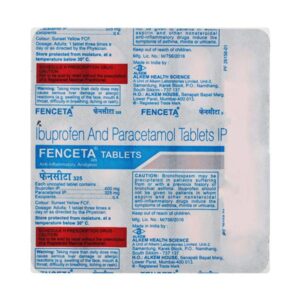IBUPROFEN + PARACETAMOL
Ibuprofen: Ibuprofen is a nonsteroidal anti-inflammatory drug (NSAID) that is commonly used to relieve pain, reduce inflammation, and lower fever. It is available over-the-counter and also in higher strengths with a prescription.
The main mechanism of action of ibuprofen is by inhibiting the production of prostaglandins, which are body chemicals responsible for pain, inflammation, and fever. By blocking the enzymes responsible for the production of prostaglandins, ibuprofen helps to reduce these symptoms.
The dosage of ibuprofen varies depending on the individual’s age, condition being treated, and the strength of the medication. For adults, the typical dose ranges from 200mg to 800mg per dose, and it can be taken every 4 to 6 hours, as needed. However, it is important to follow the instructions provided by the healthcare provider or the packaging of the specific product being used.
While ibuprofen is generally safe when used as directed, it may cause some side effects. The most common side effects include stomach discomfort, heartburn, nausea, and diarrhea. It is recommended to take ibuprofen with food or milk to help reduce the chances of stomach upset. In rare cases, ibuprofen can cause more serious side effects such as stomach ulcers, kidney problems, liver damage, allergic reactions, and cardiovascular events like heart attack or stroke. It is important to seek immediate medical attention if any severe side effects occur.
Patients with certain medical conditions or those taking specific medications should exercise caution or avoid using ibuprofen. It is important to consult with a healthcare provider or pharmacist before starting ibuprofen to ensure it is safe and appropriate for the individual’s specific situation.
Paracetamol: Paracetamol, also known as acetaminophen, is a widely used medication for the relief of pain and fever. It is available over-the-counter and is commonly used to treat headaches, toothaches, muscle aches, colds, and fevers.
The mechanism of action of paracetamol is still not fully understood. It is believed to work by inhibiting the production of certain chemicals in the body called prostaglandins, which are responsible for pain and fever. Unlike non-steroidal anti-inflammatory drugs (NSAIDs) such as ibuprofen, paracetamol primarily works on pain and fever and has little to no anti-inflammatory effects.
The typical recommended dose of paracetamol for adults is 500-1000 mg every 4-6 hours, not exceeding a total daily dose of 4 grams (4000 mg). For children, the dose is based on their weight, usually around 10-15 mg per kilogram of body weight, given every 4-6 hours as needed. It is important to follow the specific recommendations on the packaging or as directed by a healthcare professional.
While paracetamol is generally considered safe when used properly, it can have side effects, especially when taken in excessive doses or for prolonged periods. The most common side effects include nausea, vomiting, digestive discomfort, and rash. Taking too much paracetamol can also cause liver damage, so it is important to adhere to the recommended dosage. People with pre-existing liver conditions or who consume alcohol excessively should use paracetamol with caution.
It is important to note that the information provided here is a general overview and should not replace the advice of a healthcare professional. It is always recommended to read the packaging instructions and consult with a doctor or pharmacist if you have any concerns or specific medical conditions.


